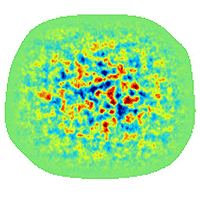Simple DC Motor DIY STEM Kit
$9.99$5.55
Posted on: Oct 27, 2014

Measurements of polarization of the cosmic microwave background
Image credit: UCSD
Cosmologists have made the most sensitive and precise measurements yet of the polarization of the cosmic microwave background.
The report, published October 20 in the Astrophysical Journal, marks an early success for POLARBEAR, a collaboration of more than 70 scientists using a telescope high in Chile’s Atacama desert designed to capture the universe’s oldest light.
“It’s a really important milestone,” said Kam Arnold, the corresponding author of the report who has been working on the instrument for a decade. “We’re in a new regime of more powerful, precision cosmology.” Arnold is a research scientist at UC San Diego’s Center for Astrophysics and Space Sciences and part of the cosmology group led by physics professor Brian Keating.
POLARBEAR measures remnant radiation from the Big Bang, which has cooled and stretched with the expansion of the universe to microwave lengths. This cosmic microwave background, the CMB, acts as an enormous backlight, illuminating the large-scale structure of the universe and carrying an imprint of cosmic history.
Arnold and many others have developed sensitive instruments called bolometers to measure this light. Arrayed in the telescope, the bolometers record the direction of the light’s electrical field from multiple points in the sky.
“It’s a map of all these little directions that the light’s electric field is pointing,” Arnold explained.
POLARBEAR has now mapped these angles with resolution on a scale of about 3 arcminutes, just one-tenth the diameter of the full moon..
The team found telling twists called B-modes in the patterns of polarization, signs that this cosmic backlight has been warped by intervening structures in the universe, including such mysteries as dark matter, composed of substance that remains unknown, and the famously aloof particles called neutrinos, which elude capture making them difficult to study.
This initial report, the result of the first season of observation, maps B-modes in three small patches of sky.
Dust in our own galaxy also emits polarized radiation like the CMB and has influenced other measurements. But these patches are relatively clean, Arnold says. And variations in the CMB polarization due to dust occur on so broad a scale that they do not significantly influence the finer resolution B-modes in this report.
“We are confident that these B-modes are cosmological rather than galactic in origin,” Arnold said.
Observations continue, and the data stream will ultimately be fed by additional telescopes comprising the Simons Array. Together they will map wider swaths of the sky, making fundamental discoveries possible.
“POLARBEAR is a real tour de force. With a relatively small, but strong, UC-led team we have surpassed the next-nearest competitors by an order of magnitude in sensitivity. We have paved the way towards solving the deepest mysteries in the quest to understand matter and energy at the beginning of time,” said Brian Keating.
POLARBEAR is a collaboration of scientists from many institutions including experiment founder, Adrian Lee, professor of physics at UC Berkeley.
The National Science Foundation provided major funding for the project. Additional funding included support by the James B. Ax Family Foundation and the Simons Foundation.
 'An expert is someone who knows some of the worst mistakes that can be made in his subject and how to avoid them.'
'An expert is someone who knows some of the worst mistakes that can be made in his subject and how to avoid them.'